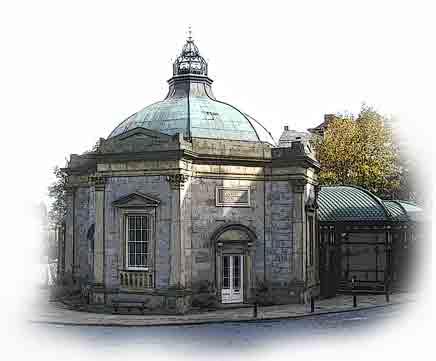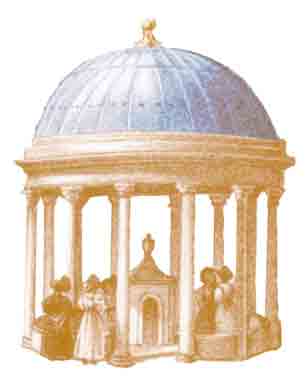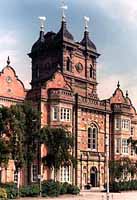
There are altogether 88 springs within a two mile radius of the pump room, sixteen of which were used medicinally.

YORKSHIRE & CLEVELAND
AYSGARTH.
Dr William Pickles (1885 - 1969), the first president of the Royal College of General Practitioners practised here for 53 years and wrote ''Epidemiology in a country practice''.
BEDALE.
The only known example of an 18thC Leech House was built on the banks of the Bedale beck and has recently been restored by Bedale Heritage Trust . Although only open to the public on certain occasions, the outside can be examined from the Bedale Renaissance Park, a public open space leading from the railway station to the water's edge. The building was used by the local apothecary for storing leeches
HARROGATE.
|
|
A museum of the spa's history is
located in the Royal Pump
Room, designed by Isaac Shutt and built in 1842 to afford better
shelter for spa visitors who wished to drink the sulphurous waters which
emanate from on of four springs beneath the floor. In the 18thC,
these springs were capped by four spring heads and the waters were taken
in the open air. One of the spring heads (though a reproduction of the
original) can still be seen at its original position below the floor of
the pump room.
|
|
In 1804, an elegant circular canopy supported on slender pillars was erected
over one of the spring heads, designed by Thomas Chippendale. When the Pump Room
was built, Chippendale's canopy was re-erected over the Tewit Well on the Stray
where it still stands.
There are altogether 88 springs within a two mile radius of the pump room, sixteen of which were used medicinally. |
 |
ILKLEY
Eighteenth century spa bath house
at White Wells, Wells Road LS29 9DT.One of the two original baths is still accessible. It is lined with stone tiles, and access to the water is by a flight of steps. Water issues into the bath through the mouth of a carved stone head. Charles Darwin is reputed to have visited Ilkley spa.This attractive north Yorkshire town with its narrow streets of Georgian houses boasts the oldest chemist shop in England, founded in 1720.
LEEDS.
, Kirkstall. 12th century Abbeygate House. Open: Monday - Saturday 10.00-5.00 Sunday 2.00-5.00. Collection of pharmacy antiquities. Three full sized streets of shops.| Thackray Medical Museum 131 Beckett St, Tel: 0113 245 7084. Email: [email protected] | |
 |
On 24th March 1997 one of Europe's largest medical museums opened in Leeds. The £5 million interactive Thackray Medical Museum looks at medicine through the eyes of ordinary people, showing how improved living conditions and medical advances help us to live around 50 years longer than we did in the 1800's.
The museum is housed in a 5,000 square meter Grade II listed building, formally the Ashley Wing of St James's Hospital. Originally opened in 1861 as the Leeds Union Workhouse, the building formed part of the hospital accommodation until 1995. The large collection of objects relating to healthcare ranges from the Roman period to the present and a library.
|
| The Yorkshire Medical and Dental History Society have a web site giving details of lectures, some of which on on subjects pertaining to medical topography | |
PICKERING.
Occupying a Regency House in the centre of Pickering, the museum houses a chemist shop which contains a beautifully hand-made drug run, with 116 individual drawers, each with a latin name for the pills or potions they contained. Most of a vast collection of medical history came from long gone local Chemist's shops such as Ann English and Norman Wood of Pickering. Open March to October.SHEFFIELD
Cholera monument and burial ground. Sheffield was struck by the first cholera epidemic in July 1832. 402 people died of the disease. At first they were buried as normal in the city's churchyards but the pressure on graveyard space coupled with public unease at living too close to diseased bodies led to a more isolated site being chosen to bury the corpses off the Norfolk Road. The Victorian monument commemorating the epidemic was recently restored by the city council after the top was blown off in a gale.
WAKEFIELD.
The
Stephen Beaumont Museum of Mental Health
was previously accommodated in the Stanley Royd Hospital at Aberford Rd (formerly the West Riding
Pauper Lunatic Asylum built in1818). When the hospital closed in 1995, the
museum was moved to Fieldhead Hospital in Ouchthorpe Lane. The museum depicts the
story of the Asylum and contains restraining equipment, a padded cell, and
medical and surgical equipment documents. (The treatment record books are in the County Record
Office.) There is also a scale model of the original 1818 building and
photographs dating from 1862.
The museum is open each Wednesday, from 10am to 4.30pm. Entrance is free.
There are adequate wheel chair facilities and adjacent free parking.
Intending visitors should contact the curator by telephoning 01924 328654. Groups are welcome and talks can be arranged
YORK.
There was a cholera burial ground opposite the railway station. York was the birth place of Dr John Snow, anaesthetist and epidemiologist.
The Retreat was established 1792 by members of the Tuke family for the humane treatment of mental illness. Much of the original building, designed by John Bevans, remains though there have been many alterations and additions since. The Retreat is now an independent hospital with 160 beds, including 100 for the elderly. It specializes in certain areas, such as post-traumatic stress treatment, eating disorders, and medical personnel with addictions or mental illness.